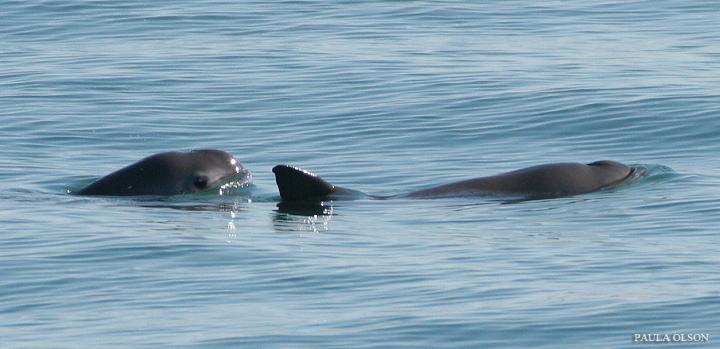
This is a vaquita photo taken from the Secretaria de Medio Ambiente y Recursos Naturales (SEMARNAT), within a natural protected area subject to special management. A new method of teasing information from scarce and highly degraded genetic samples is helping NOAA Fisheries and Mexican scientists unravel the genetic heritage of the enigmatic vaquita, the most endangered marine mammal on Earth.
Genetic studies are important to the international effort to conserve the vaquita because the DNA that holds their genetic code can unlock the secrets of how they came to be. For instance, it can reveal the story of how - and how long ago - the animals evolved into a unique species adapted to warm desert surroundings when most porpoises live in cool waters.
But scientists probing vaquita DNA face one major problem: Fewer than 100 vaquita remain in the murky waters of the northern Gulf of California, and they are so wary and skittish that even experts have a hard time finding them, much less collecting samples of their DNA.
Most of the available genetic samples of vaquita come from animals inadvertently killed in fishing nets, a chief cause of mortality, and have usually deteriorated by the time they reach a laboratory. NOAA Fisheries' Southwest Fisheries Science Center in La Jolla, Calif., houses one of the largest collections of marine mammal DNA in the world, but even its best samples of vaquita DNA are at least 10 to 15 years old and have additionally deteriorated with time.
"It's very difficult to get these samples because the animals are so rare and hard to find, and the few samples we do have are old and probably not in very good shape," said Phillip Morin, a research molecular biologist in the Southwest Fishery Science Center's Marine Mammal Genetics Group.
Enter Swift Biosciences, a small biotechnology company based in Ann Arbor, Michigan, that has developed new methods for working with damaged and highly degraded DNA. While traditional methods require sizeable samples of intact DNA in its double-stranded form, Swift's " next-generation" DNA sample preparation approach can extract genetic material even from bits and pieces of single-stranded DNA that have severely degraded over time.
"This new technology allows you to get useful genetic information from vanishingly small amounts of DNA," said Timothy Harkins, president and chief executive officer at Swift Biosciences. "This works where other approaches would fail as they cannot address the many challenges encountered with highly degraded DNA. Samples that might have once seemed too degraded to do anything with can now provide genetic insight, a valuable tool to help preserve our wildlife resources."
Swift initially partnered with NOAA by testing the Swift DNA sequencing kits using samples from harbor porpoises, close relatives of vaquita but not endangered. The kits successfully converted the highly degraded harbor porpoise samples into genetic libraries that can be further analyzed with genomic sequencing technologies.
"We had tested this kit with single-stranded DNA during our development, and it was exciting to see 100 percent success in applying it to something as unique and degraded as the porpoise DNA samples," said Swift scientist Cassie Schumacher, who completed processing and sequencing of the samples.
Morin's team then applied the technology to 12 samples of vaquita DNA - including some that were even more degraded and of poorer quality than the harbor porpoise samples. The Swift sample preparation system produced useful data from all of the vaquita samples.
"I knew the DNA we had was really old and degraded so it seemed very unlikely it would lead to anything useful," said Barbara Taylor, the SWFSC's leading vaquita biologist. "It was a pleasant surprise to find that we had been able to generate genetic information that had seemed beyond reach without the Swift technologies."
The technologies open the door to tools and techniques for deciphering genetic information that were not available when the vaquita DNA was first collected, she said. For instance, scientists may now pinpoint the parts of the vaquita's genetic code that provide the unique adaptations that allow them to live in a warmer environment than other porpoise species.
There is not much of a fossil record for porpoises, so genetics also provides the only real way to understand the animal's evolutionary history. Initial findings from the new research now confirm that vaquita apparently split from another species of porpoise from the Southern Hemisphere about 2 to 3 million years ago and have since survived on their own, in relatively small numbers.
"Like camels, they've adapted to be able to live in this unusual inland sea surrounded by desert, and their genetics help us understand how that might have come about," Taylor said.
"If we want to understand what's unique about vaquita, we have to know how they are related to other porpoises," Morin said. "Now we know they're most closely related genetically to a species from the Southern Hemisphere that is geographically farther away than other porpoise species in the North Pacific."
"We can tell that the vaquita is a unique species that has been separate for as much as 3 million years and now it's on the very brink of extinction," he said.
The SWFSC genetics lab plans to apply Swift's technology to other degraded DNA samples, with hopes of detecting even more evolutionary clues.
"When you consider how much more data you can now obtain from samples like this, even degraded DNA becomes a treasure trove of scientific information," Harkins said.
Source: NOAA Fisheries West Coast Region
 Print Article
Print Article Mail to a Friend
Mail to a Friend
